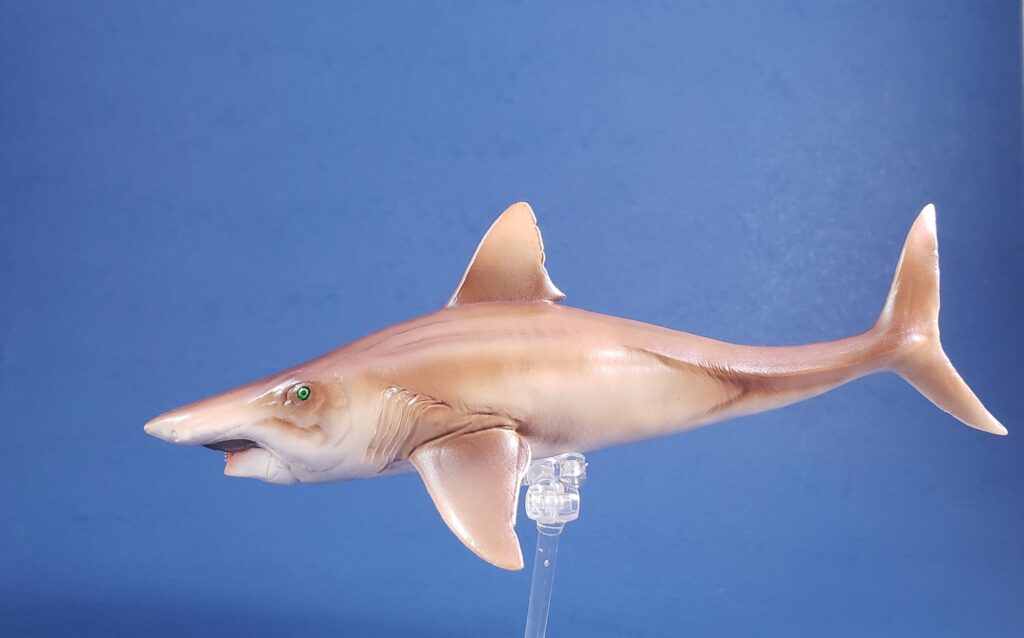
270 million years before orcas, 250 million years before megalodon sharks, 170 million years before even the mosasaurs, the largest macropredators in the ocean were probably eugeneodontids, large fishes with bizarre tooth arrangements and cartilaginous skeletons. They’re often referred to as sharks, although their jaw mechanics and tooth morphology suggest that they were more closely related to modern chimaeras, or ratfishes. But if you hear someone call the giant Helicoprion by its popular name “buzzsaw shark,” let them–I promise there are bigger fish to fry. For 2021, PNSO has included this iconic spiral-toothed stem-ratfish in their Prehistoric Animal Models line. How’d they do?

Nicknamed “Haylee” by PNSO, this model measures around 20 cm from snout to the fork in its tail. There’s a large range of sizes of preserved tooth whorls, meaning that this figure can work anywhere from 1:20 to 1:40 scale. It’s a multi-part mold with a very fine seam around the pectoral region and an articulated lower jaw. The left pectoral fin says “©2020 PNSO, MADE IN CHINA” and bears the CE European safety seal; the right bears the embossed signature of Zhao Chuang, who sculpts, or directs the sculpting of, the models in PNSO’s range. In photos, the color scheme is conservative, medium unsaturated brown above and paler beneath with a touch of pink. There’s a very tiny indentation to indicate the cloaca. In person, it has purple and green iridescence, unlike most sharks but like some ratfishes, such as the opal chimaera Chimaera opalescens. This sheen and the green eyes appear to be nods to shared holocephalan ancestry.
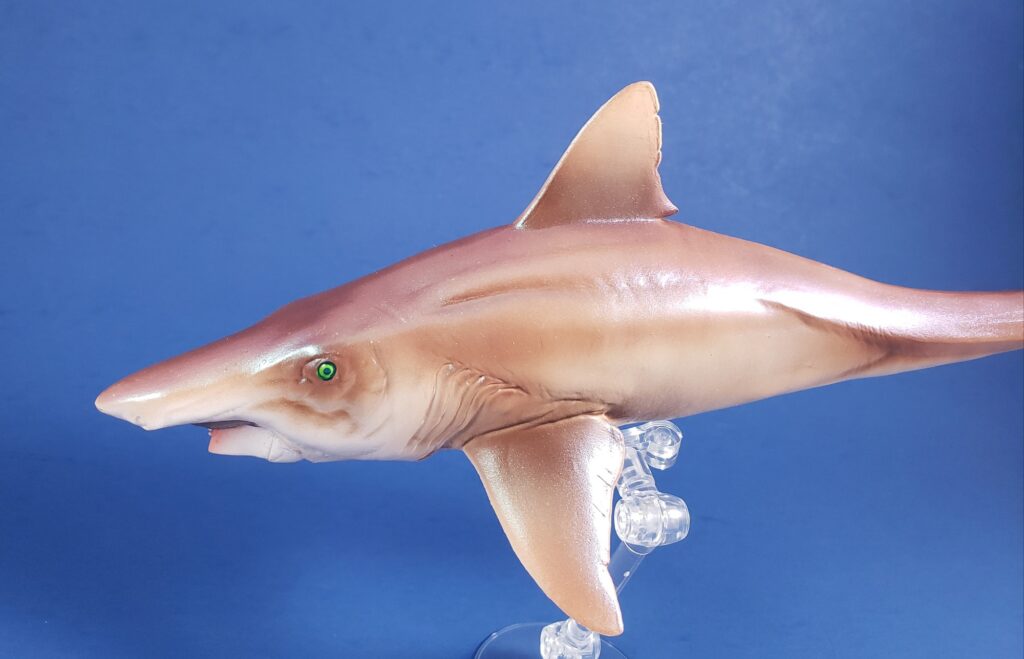
It’s important to remember that Helicoprion is known only from jaw elements, so a lot of the way it is depicted here has been inferred from better-preserved relatives separated by tens of millions of years of evolution. That means any evaluation of accuracy is assuming a lot, so keep that in mind as we go through this. The dorsal fin is triangular, the pectoral fins are broad and moderately large, and the tail is crescent shaped, all of which are appropriate for a big pelagic predator, and all of which are consistent with exceptional specimens of the distant Helicoprion relatives Caseodus and Fadenia. Compared to a shark, you might notice that this model is missing the anal and pelvic fins. Some modern sharks have also lost the anal fin, and fossils of the aforementioned Caseodus lack an anal fin, so this is pretty reasonable. Caseodus appears to lack pelvic fins as well, which is pretty strange because both sharks and chimaeras mate via internal fertilization using organs called pelvic claspers. The claspers are derived from the pelvic fin of the male, so it’s unclear how eugeneodontids would have mated if they really lacked pelvic fins. It is also possible that, since the pelvic girdle of a fish is only attached by muscle, rather than fastened to the vertebrae as in a tetrapod, the pelvic fins simply didn’t preserve with the rest of the skeleton of Caseodus. The mystery of Helicoprion mating notwithstanding, sculpting it without pelvic fins is probably the safest choice given the available evidence. We’ll just have to wonder how it would have made copies of itself.
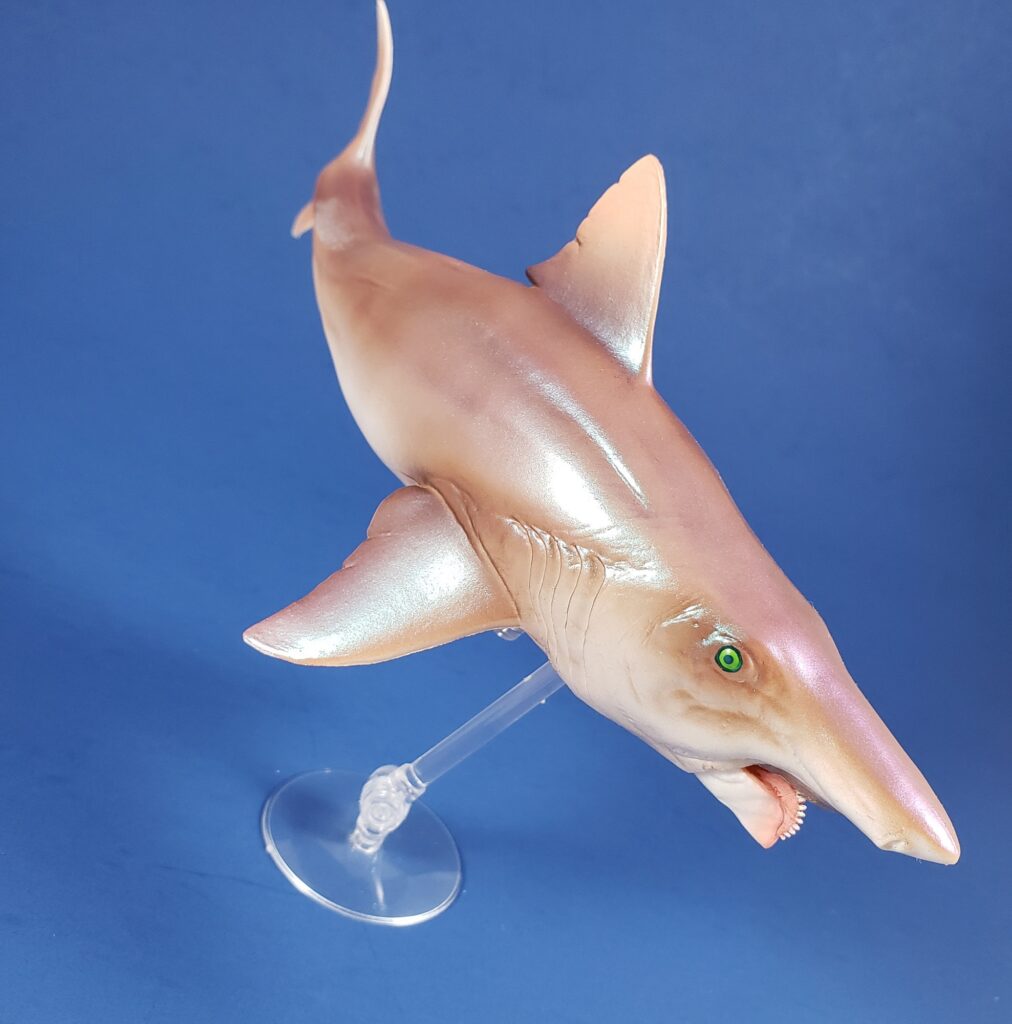
The head is perhaps a bit outsized, although without a complete skeleton of Helicoprion I can’t say that with much confidence. There are five gill slits between the head and pectoral fin, which is the likeliest number (there might have been as many as six). Here PNSO avoided the temptation to make it too ratfish-like. Modern chimaeras have their gills covered with a single flap called an operculum, but this is an odd feature specific to them, and early members of the Holocephali would have had separate slits as shown here. There is an odd dimple between the eye and the jaw, as well as some other grooves sculpted into the head. I’m not sure what they’re meant to represent, but you could interpret them as exaggerated lateral line canals. It might have just been PNSO trying to add some visual interest so that nobody would accuse it of not being detailed enough. The four nares are well-sculpted, but are probably a bit too prominent. We don’t know for sure how long the rostrum of Helicoprion was; these days it’s common to give it a fairly abbreviated rostrum as shown in Tapanila et al. 2013, but one used to see a lot of very long snouts, as in Safari Ltd’s 2011 miniature version. This snoot is in the range of plausible proportions, in my estimation.
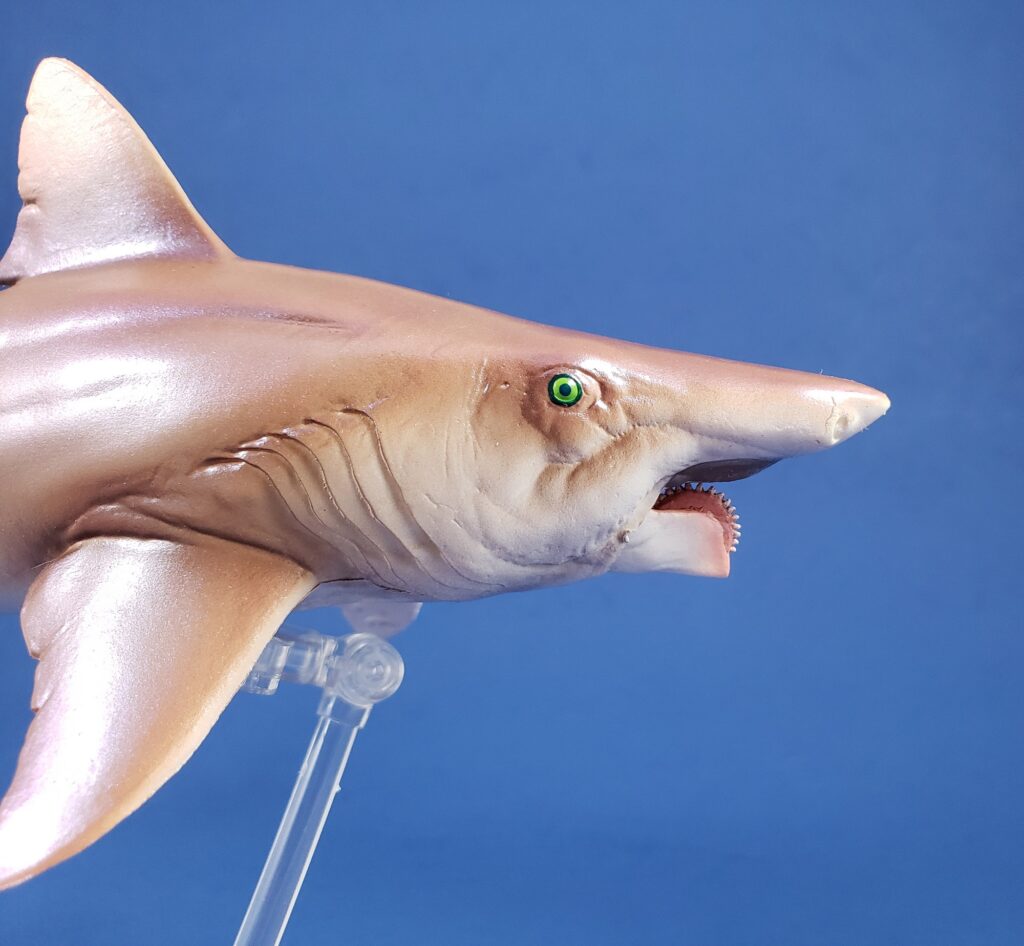
Now to the part of the animal that is actually known: the jaws. Articulated specimens show that the bizarre tooth whorl actually rested inside the mouth, and given that some of these whorls were up to 50 cm in diameter, their owners must have been enormous animals. The lower jaw, or Meckel’s cartilage, formed a hinge with the upper jaw, or palatoquadrate, while the palatoquadrate itself was fused to the braincase, immobile. This differs from most sharks, whose upper jaws are slung by ligaments from the skull, which is why they look like they’re throwing their entire mouth forward when they strike. Helicoprion was instead chasing down prey, perhaps cephalopods, and forcing it backward by using the tooth whorl as a kind of ratcheting shredder.

The lower jaw of Helicoprion was flanked by labial cartilages, which were somewhat columnar in shape and might have kept the jaw from closing all the way and scrambling the fish’s brain with all those teeth. The labial cartilages seem to be mostly or entirely absent here. The dark patch on the upper jaw of this figure seems to represent a pavement of cartilage that might have been on the roof of the mouth to house the teeth at rest, although there is no reason to suspect that such a thing would have been externally visible. It sort of seems like someone has cut away parts of the mouth to make the teeth and palatal cartilage more obvious–maybe PNSO’s sculptors were afraid it would look too much like a regular old shark if they gave it an intact mouth, but then again they’ve made two megalodon figures.
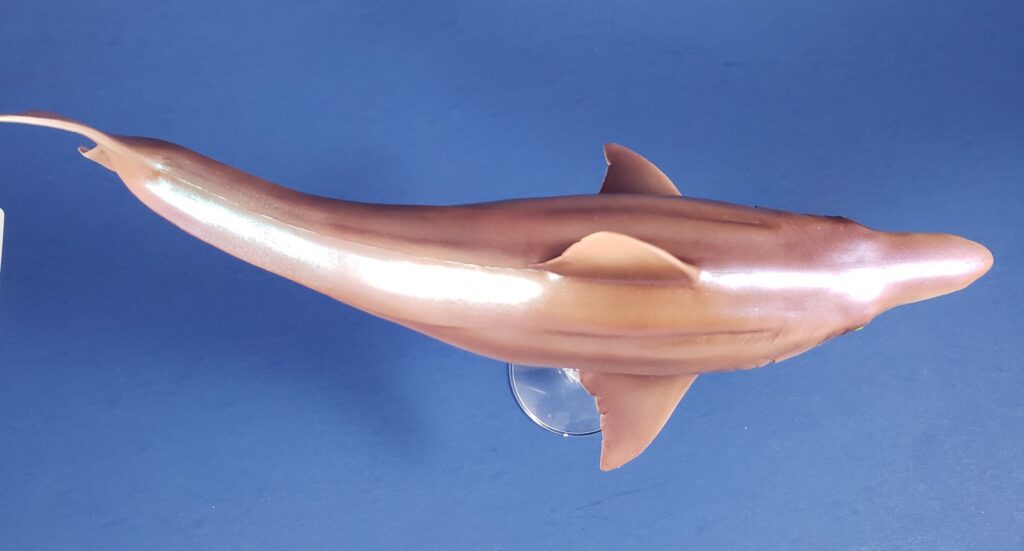
At the other end of the animal–and remember, we are back to inferring from relatives–the tail is a bit weedy. Given the size of the head and abdominal cavity, I would have given this animal a little more engine at the back. There is a horizontal thickening approaching the tail, called a caudal keel, which a fish with this overall shape would likely have had. A keel stabilizes the fish and improves the efficiency of tail-beating. The upper lobe of the tail fin should probably be thicker left-to-right, since it would have contained vertebrae in life; this model seems to suggest that the vertebral column ends where the tail forks. The body is mostly smooth, which is commendable, although a few ridges and folds are present to suggest flexion and musculature.

In many ways this is a fairly typical release for PNSO. It’s a beautiful, visually interesting sculpt that reflects some real thoughtfulness on the part of the artists about the animal as it might have lived. Also typically for PNSO, there are a few anatomical liberties and odd proportions. Only a few of these are demonstrably wrong, such as the labial cartilages, but several more are merely unlikely. All in all, it’s easily the most up-to-date and attractive toy of a eugeneodontid. There aren’t many, so that might sound like I’m damning with faint praise, but I want to be clear that I think this is quite a good model. I’m very happy to have it, and I’d recommend it to almost anybody who is interested in ancient life. With its pliable fins and lack of pointy bits, I think it’s safe for all but the youngest children.
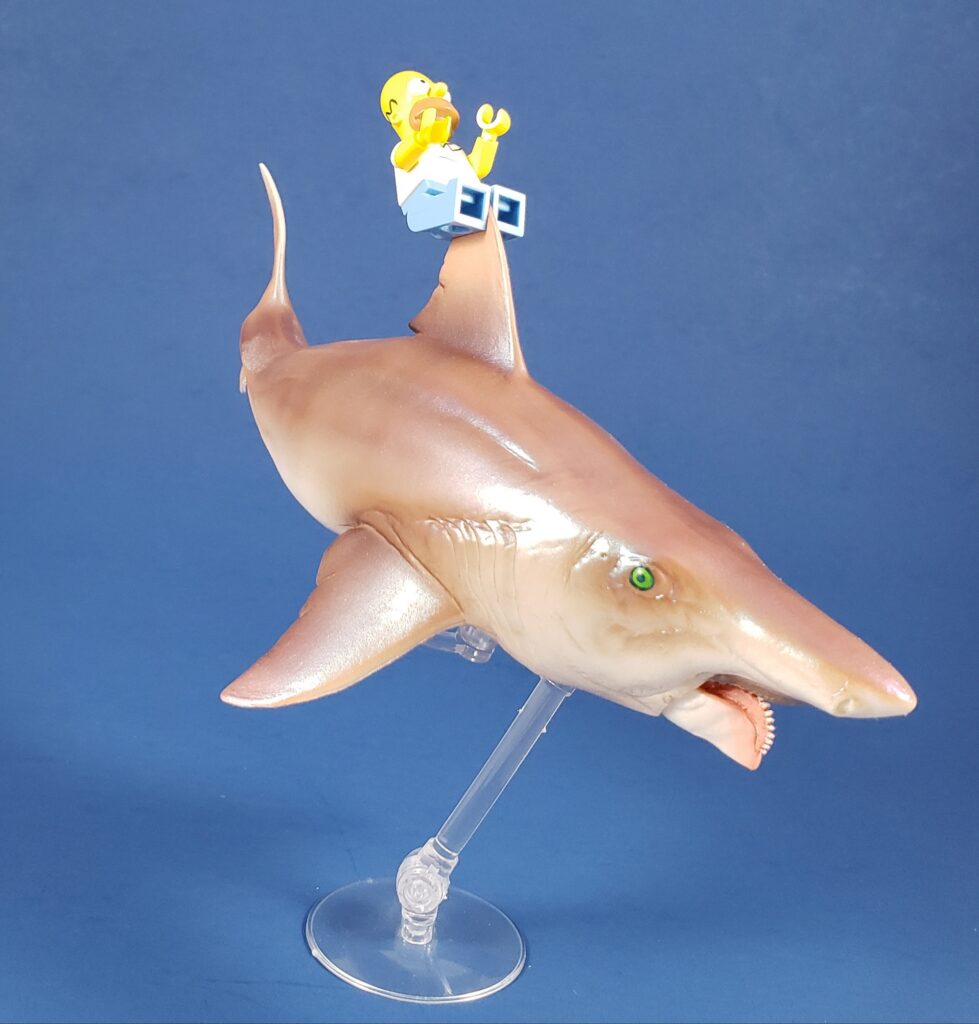
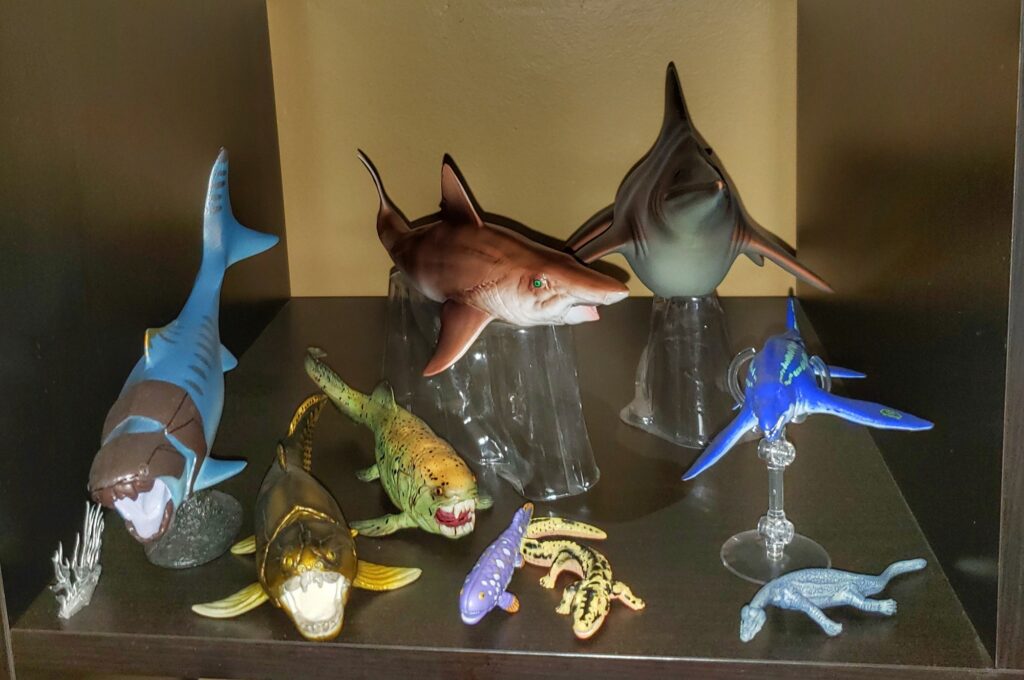
Disclaimer: links to Ebay and Amazon on the DinoToyBlog are affiliate links, so we make a small commission if you use them. Thanks for supporting us!




a great figure and one of my most anticipated releases this year. Great review of it.
For reproduction, is it possible that the females laid their eggs and the males fertilized them, forgoing internal fertilization?
It’s possible, but it would be very surprising. All the evidence suggest that chondrichthyan fishes have had internal fertilization for their entire history. Placoderms also had internal fertilization, so it would seem that the external fertilization seen in bony fishes is actually the more derived trait.
Without a doubt one of the best fish made by this brand together with its megalodon. If one day I buy a PNSO figure again I will focus on the helicoprion as well as the machairoceratops and sinoceratops, in general on those rare PNSO figures on the toy market. That fight-worn upper fin gives it a very realistic feel. He is a great figure and I also congratulate Halichoeres for this excellent article.
Wonderful review of this lovely figure.
PNSO we now know can make good fish figures, hopefully this won’t be the last one from them. Can you Imagine how awesome a Xiphactinus from them would be?
This figure dominates my fossil display shelf.
So glad we got so many prehistoric fishes this year, such as a long overdo return of Helicoprion, a Xiphactinus, and a Dunkleosteus with simultaneous upper and lowe jaw articulation, and yes I’m also including Oammararak’s fine sculpts.
Anyways fine review and if/when I can get back into the game this is just one of many I plan to get caught up on.
Mine just arrived two days ago and I am excited to have it (and it’s not as big as I had initially thought). Replaces the Safari TOOB version in my synoptic non-arthropod collection.
Definitely makes my top 5 list for 2021. I adore this figure. Excellent review, as always.
Love this toy. A highlight of my prehistoric fish shelf.